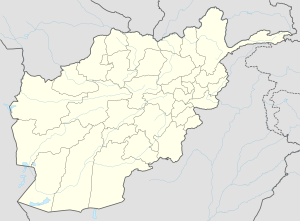
Back حصار خوست Arabic خوست موحاصیرهسی AZB Sitio de Jost Spanish محاصره خوست Persian Siège de Khost French Assedio di Khost Italian Opsada Kosta Serbo-Croatian Host Kuşatması Turkish
| Siege of Khost | |||||||
|---|---|---|---|---|---|---|---|
| Part of the Soviet–Afghan War and the Afghan Civil War (1989–1992) | |||||||
| |||||||
| Belligerents | |||||||
|
|
| ||||||
| Commanders and leaders | |||||||
|
|
| ||||||
During the nine-year Soviet–Afghan War in the 1980s and the subsequent Afghan civil war, the town of Khost was besieged for more than eleven years. Its airstrip's 3 km runway served as a base for helicopter operations by Soviet forces.
It began soon after the invasion of Afghanistan by Soviet troops, when Afghan guerillas took control of the only land route between Khost and Gardez, effectively putting a stop to the Soviet advance.[citation needed]
At the end of July 1983, the forces of Jalaluddin Haqqani laid siege to two towns in Khost and the Tani, Mangal, Zazai and Waziri tribes began taking an active part in the fighting, despite being passive up until then. All of the aforementioned events coincided with former King Mohammed Zahir Shah's appeal for a united front, which caused rumours about the Royalists intending to establish a provisional government in a liberated Khost. However, Khost wasn't captured and by October, the Tani tribe had withdrawn from coalition due to a tribal rivalry with the Zadran. Many rebels also returned home as winter came on. By the end of December, government forces arriving from Gardez ended the siege of the two towns and recaputered Zazi Maidan.[4]
Operation Magistral was an offensive launched to relieve it at the end of 1987. The first convoys reached Khost at the end of December 1987. When the main Soviet force had withdrawn, Mujahideen groups cut off Khost once again, as they had done since 1981.
Following the creation of the Commander's Shura, which united the Peshawar Seven and assault was coordinated to capture Khost, an assault which at least according to former special envoy to the Mujahideen Peter Tomsen was more an ISI operation than a Mujahideen one.[5] This fighting was a co-ordinated attack by the forces of Hezb-e Islami of Gulbuddin Hekmatyar, Jalaluddin Haqqani and local Ahmadzai tribes led by Mohammad Nabi Mohammadi. The Ahmadzai were able to spearhead the assault after Hezb-e Islam and Haqqania suffered setbacks, and eventually able to capture the city and negotiate the surrender of the garrison resulting in victory on March 31, 1991.[6]
- ^ Coll 2004, pp. 226–227.
- ^ Maley 1998, pp. 63.
- ^ Roblin, Sebastien (2019-03-16). "Pakistan's F-16s Battled Soviet Jets—and Shot Down the Future Vice President of Russia". The National Interest. Retrieved 2024-03-29.
- ^ Roy, Oliver (November 30, 1990). Islam and resistance in Afghanistan. Cambridge University Press; 2nd edition. p. 198. ISBN 978-0521397001.
- ^ Tomsen, Peter. The Wars of Afghanistan: Messianic Terrorism, Tribal Conflicts, and the Failure of Great Powers. 2011
- ^ Tomsen, Peter
